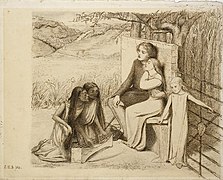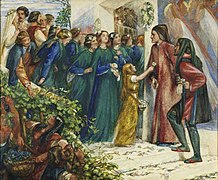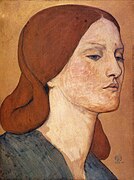Elizabeth Siddal
Elizabeth Siddal | |
|---|---|
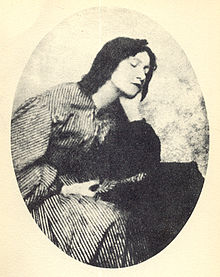 Siddal, c. 1860 | |
| Born | Elizabeth Eleanor Siddall 25 July 1829 London, England |
| Died | 11 February 1862 (aged 32) Blackfriars, London, England |
| Occupations |
|
| Spouse | |
Elizabeth Eleanor Siddall (25 July 1829 – 11 February 1862), better known as Elizabeth Siddal (a spelling she adopted in 1853[a]), was an English artist, artists' model, and poet. Siddal was perhaps the most significant of the female models who posed for the Pre-Raphaelite Brotherhood. Their ideas of female beauty were fundamentally influenced by her, or that she personified these ideals. Walter Deverell, William Holman Hunt, and John Everett Millais all painted Siddal, and she was the model for Millais' famous painting Ophelia (1852). Early in her relationship with Dante Gabriel Rossetti, Siddal became his muse and exclusive model, and he portrayed her in almost all his early artwork depicting women. Siddal became an artist in her own right and was the only woman to exhibit at a 1857 Pre-Raphaelite exhibition. Significant collections of her artworks can be found at Wightwick Manor and the Ashmolean. Sickly and melancholic during the last decade of her life, Siddal died of a laudanum overdose in February 1862 during her second year of marriage to Rossetti.
Early life
Elizabeth Eleanor Siddall, named after her mother, was born on 25 July 1829,[3] at the family's home at 7 Charles Street, Hatton Garden.[4] Her parents were Charles Crooke Siddall, and Elizabeth Eleanor Evans, from a family of English and Welsh descent.[5] She had two older siblings, Ann and Charles Robert.[6] At the time of her birth, her father had a cutlery-making business.[5]
About 1831, the Siddall family moved to the less affluent borough of Southwark, in south London.[7] The remainder of the Siddall children were born in Southwark; Lydia, to whom she was particularly close; Mary, Clara, James and Henry.[7] Elizabeth Eleanor Siddall "received an ordinary education, conformable to her condition in life" and first "read Tennyson by finding one or two poems of his on a piece of paper" that had been wrapped around some butter.[8] Literary analysts have noted that her artwork sometimes used subjects from Tennyson's writings and that his writings may have influenced her poetry.[9][10][11]
Pre-Raphaelite model

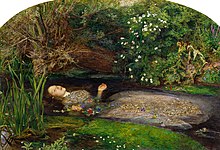
In 1849, while working at a millinery in Cranbourne Alley, London,[12][13] Siddal made the acquaintance of Walter Deverell. Accounts differ on the circumstances of their meeting: In one account, William Allingham visited the milliner's to meet a woman he was acquainted with and admired; Sidal was the woman's co-worker and joined the pair on their walk home, as it was the women's usual practice to travel home from work together. Siddal made such an impression on Allingham that he recommended her as a possible model to his friend Deverell, who was struggling with a large oil painting based on the Shakespeare play Twelfth Night.[14] Another account has Deverell accompanying his mother to the millinery where he noticed Siddal in the back of the shop.[15] In either case, Deverell later described Siddal as "magnificently tall, with a lovely figure, and a face of the most delicate and finished modelling ... she has grey eyes, and her hair is like dazzling copper, and shimmers with luster."[16] Deverell subsequently employed Siddal as a model and introduced her to the Pre-Raphaelites.[17]
As with the other Pre-Raphaelites, Deverell took his inspiration directly from life rather than from an idealized classical figure. In his Twelfth Night painting, he based Orsino on himself, Feste on his friend Dante Gabriel Rossetti and Viola/Cesario on Siddal. This was the first time Siddal sat as a model.[18] According to William Michael Rossetti, Dante Gabriel's brother, "Deverell drew another Viola from her, in an etching for The Germ."[19][20] Elaine Shefer asserts that Deverell portrayed Siddal in A Pet and The Grey Parrot.[21]
William Holman Hunt painted her in A Converted British Family Sheltering a Christian Missionary from the Persecution of the Druids (1849–1850)[19] and Two Gentlemen of Verona, Valentine Rescuing Sylvia From Proteus (1850 or 1851).[22][23]
For Millais's Ophelia, Siddal floated in a bathtub full of water to portray the drowning Ophelia. Millais painted daily through the winter, putting oil lamps under the tub to warm the water. On one occasion, the lamps went out and the water became icy cold. Millais, absorbed by his painting, did not notice and Siddal did not complain. After this, she became ill with a severe cold or pneumonia. Her father held Millais responsible and, under the threat of legal action, Millais paid her doctor's bills.[24]
Relationship with Rossetti
Dante Gabriel Rossetti met Siddal in 1849, probably while they both modelled for Deverell.[19] Rossetti gave Siddal the nickname "Lizzie" when she entered the Pre-Raphaelite Brotherhood circle, and "the diminutive enhanced her youthful, dependent role."[25] By 1852, she had become Rossetti's main model and muse, and he stopped Siddal from modelling for others.[26]

In 1852, she began to study with Rossetti. That same year, Siddal became lovers with Rossetti and moved into his Chatham Place residence. They subsequently became anti-social and absorbed in each other's affections. They coined affectionate nicknames for one another, such as "Guggums" or "Gug"[27] and "Dove", the latter one of Rossetti's names for Siddal.[28][29] He also shortened the spelling of her name to Siddal, dropping the second l.[1]
Perhaps Rossetti's most abundant and personal works were his idealized pencil sketches of Siddal at home, most of which he entitled simply "Elizabeth Siddal". In these sketches, he portrayed Siddal as a woman of leisure, class, and beauty, often situated in comfortable settings. She also became the subject of much of Rossetti's poetry. One poem, A Last Confession, extolls his love for Siddal, whom he personifies as the heroine with eyes "as of the sea and sky on a grey day."[30]
Beginning in 1853, Rossetti used Siddal as a model for a series of Dante-themed paintings, including The First Anniversary of the Death of Beatrice (1852), Beatrice Meeting Dante at a Marriage Feast, Denies him her Salutation (1851), Dante's Vision of Rachel and Leah (1855), and, perhaps his most famous portrait of her, Beata Beatrix (1864–1870), which he painted as a memorial after her death.[29]
It has been estimated that there are thousands of Rossetti's drawings, paintings, and poems in which Siddal was a subject.[31]
Artwork and poetry

In 1853, Siddal signed The Lady of Shalott as "E. E. Siddal", the first known record of her shortened surname.[2] By that same year, Rossetti had taken Siddal on as a student.[32] He told his friend Ford Madox Brown that her "fecundity of invention and facility are quite wonderful, much greater than mine."[33] Siddal seems to have inspired Rossetti, as he followed her in depicting the same subjects, and he reused her designs after her death.[33]
In 1854, Siddal painted a self-portrait that diverged from the typical Pre-Raphaelite idealised beauty.[34][33] In 1855, art critic John Ruskin began to subsidise her career and paid £150 per year in exchange for all the drawings and paintings she produced. She produced many sketches, drawings, and watercolours as well as one oil painting. Her sketches are similar to other Pre-Raphaelite compositions illustrating Arthurian legend and other idealized medieval themes, and she was the only woman who exhibited with the Pre-Raphaelites at an 1857 exhibition at No. 4 Russell Place, Fitzroy Square, London.[35][36][22]
During Siddal's career as an artist and poet from 1852 to 1861, she produced more than a hundred works.[37] Unpublished during her lifertime, her poetry often dwelt on dark themes, lost love, or the impossibility of true love. Her small poetic output was nonetheless accomplished. Constance Hassett wrote that "Siddal's poetry ranges from the perfectly realized ballad narrative, to its opposite, the overheard lyric, and to something in between, the made-to-be heard monologue."[9] Critic William Gaunt wrote that "Her verses were as simple and moving as ancient ballads; her drawings were as genuine in their medieval spirit as much more highly finished and competent works of Pre-Raphaelite art."[38]
Relationship with Rossetti's family and marriage

As Siddal came from a working-class family, Rossetti feared introducing her to his family.[39] Siddal was the victim of harsh criticism from his sisters.[40] The knowledge that his family would not approve contributed to Rossetti delaying the marriage.[41] Siddal appears to have believed, with some justification, that Rossetti was always seeking to replace her with a younger muse, which contributed to her later depressive periods and illness.[42]
Shortly before their marriage, Rossetti produced a famous portrait of Siddal, Regina Cordium or The Queen of Hearts (1860). This painting is a close-up, vibrantly coloured depiction of Siddal.[43][44]
Siddal and Rossetti married on Wednesday, 23 May 1860 at St. Clement's Church in the seaside town of Hastings. There were no family or friends present, only a couple of witnesses whom they had asked in Hastings.[45]
Ill health and death
In Elizabeth Siddal's constitution there was a consumptive taint. This may, I suppose, have come from the father; for the mother was a healthy woman, living on til past ninety.
— William Michael Rossetti, Dante Gabriel's brother[8]
It was thought that she suffered from tuberculosis, but some historians believe an intestinal disorder was more likely. Elbert Hubbard wrote that "She suffered much from neuralgia, and the laudanum taken to relieve the pain had grown into a necessity."[46] Others have suggested she might have been anorexic while others attribute her poor health to a laudanum addiction or a combination of ailments.[47]
Siddal travelled to Paris and Nice for several years for her health. At the time of her wedding, she was so frail and ill that she had to be carried to the church, despite it being a five-minute walk from where she was staying. She became severely depressed and her long illness gave her access to laudanum to which she became addicted. In 1861, Siddal became pregnant, which ended with the birth of a stillborn daughter. The stillbirth left Siddal with post-partum depression. She became pregnant for a second time in late 1861. Siddal overdosed on laudanum on 10 February 1862. She, Rossetti, and his friend Algernon Charles Swinburne had dined together in a nearby hotel. After having taken Siddal home, Rossetti attended his weekly lecture at the Working Men's College. Upon returning home from teaching, Rossetti found Siddal unconscious in bed and could not revive her.[46] The first doctor Rossetti called claimed that he was unable to save her, upon which Rossetti sent for another three doctors. A stomach pump was used, but to no avail. She died at 7:20 am on 11 February 1862 at their home at 14 Chatham Place. The coroner ruled her death as accidental; however, there are suggestions that Rossetti found a suicide note, with the words "Please look after Harry" (her invalid brother, who may have had a slight intellectual disability), supposedly "pinned ... on the breast of her night-shirt."[48][49] Consumed with grief and guilt Rossetti allegedly went to see Ford Madox Brown who is supposed to have instructed him to burn the note.[22] Since suicide was illegal and considered immoral, it would have brought scandal on the family and barred Siddal from a Christian burial.[50]
After Siddal's death
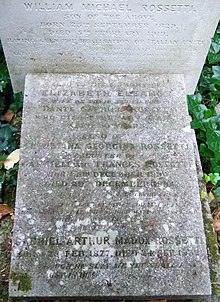
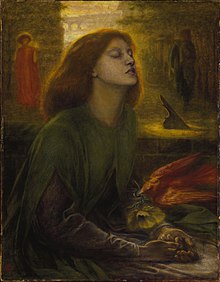
Siddal was buried with her father-in-law Gabriele on 17 February 1862 in the Rossetti family grave in the west side of Highgate Cemetery. Later burials in the same grave are her mother-in-law Frances Rossetti (1886), Christina Georgina Rossetti (1895), and William Michael Rossetti (1919).[51]
In August 1869, Rossetti authorized Charles Howell to disinter her coffin to retrieve a handwritten book of Rossetti's poems, which he had laid beside her head before burial. With the aid of a Dr. Llewelyn Williams and two others, Howell accomplished this in October 1869. Dr. Williams subsequently disinfected the book.[52] Rossetti then published the contents in Poems (1870).[53]
These became part of Rossetti's sonnet sequence entitled The House of Life. This sequence contained the poem "Without Her", a reflection on life once love has departed.
What of her glass without her? The blank grey
There where the pool is blind of the moon's face.
Her dress without her? The tossed empty space
Of cloud-rack whence the moon has passed away.
Her paths without her? Day's appointed sway
Usurped by desolate night. Her pillowed place
Without her? Tears, ah me! For love's good grace,
And cold forgetfulness of night or day.
What of the heart without her? Nay, poor heart,
Of thee what word remains ere speech be still?
A wayfarer by barren ways and chill,
Steep ways and weary, without her thou art,
Where the long cloud, the long wood's counterpart,
Sheds doubled up darkness up the labouring hill.— Dante Gabriel Rossetti, "The House of Life", Ballads and Sonnets[54]
Legacy
Their home at 14 Chatham Place was demolished[55] and is now covered by Blackfriars Station.[56]
Exhibitions and collections

A retrospective of Siddal's work was curated by Jan Marsh in 1991 at the Ruskin Gallery in Sheffield.[57][58]
Rosalie Glynn Grylls bought some of Siddal's works at auction in 1961. These works became part of Wightwick Manor, donated by her and her husband, Geoffrey Mander, to the National Trust. A 2018 exhibition, "Beyond Ophelia", curated by National Trust Assistant Curator Hannah Squire, ran at for nine months and featured twelve artworks by Siddal and owned by the National Trust. Only the second solo exhibition of her work, the exhibition examined Siddal's career, artistic style, subject matter, and the recognition challenges she faced as a female artist.[59][60]
Siddal was among the women featured in the 2019 Pre-Raphaelite Sisters exhibition at London's National Portrait Gallery.[61][62]
Running[update] until 24 September 2023[needs update], The Tate Gallery has The Rossettis exhibition[63] that includes 17 of Siddal's works.[64][33]
Works inspired by Siddal
Literature

Writer and curator Jan Marsh wrote that those fascinated by Siddal included Swinburne, Oscar Wilde, and Arthur Symons. The artist and author Charles Ricketts confessed that "Oh, we have all, when young, been in love with Miss Siddal." With the emerging fields of psychology and sexology, a reevaluation of Siddal in fiction, poems, and biographies occurred in the 1920s and 1930s. She became regarded as "a morbid, hysterical, suicidal woman clinging to her virginity and angrily jealous of her rivals." By the mid-twentieth century, perceptions had changed again so that Siddal became "a Pre-Raphaelite groupie, a child of the 1950s and 60s pop culture." Finally from the 1980s onward, authors and biographers reassessed Siddal, a reexamination in which she emerges as "partly a victim of masculine oppression and partly a rediscovered proto-feminist", and a rediscovery that includes "a determined effort to detach Elizabeth Siddal's story from that of Rossetti and the PRB, ... and present her with a biography of her own."[25]
Along with Algernon Charles Swinburne, Siddal and Rossetti are also the subjects of a work with the same title, "How They Met Themselves", that is part of The Sandman series by Neil Gaiman, drawn by Michael Zulli, and published in Vertigo: Winter's Edge #3 (2000). In it, a dying Lizzie drugged with laudanum has a last dream or vision in which the trio takes a train trip to a forest "where they each would see their true love."[66][67] This story bears the same name as a drawing and a painting by Rossetti that depict Siddal.[68]
Ophelia's Muse is a 2015 historical novel by Rita Cameron. It tells the story of Siddal and the Pre-Raphelites.[69]
Television
Rossetti's relationship with Siddal has been the subject of television dramas, notably Dante's Inferno (1967), by Ken Russell, in which she was played by Judith Paris and Rossetti by Oliver Reed;[70] The Love School (1975) in which she was played by Patricia Quinn;[71] and Desperate Romantics (2009) in which she was played by Amy Manson.[71]
Art
Siddal is depicted on one of the plates in The Famous Women Dinner Service by Vanessa Bell and Duncan Grant, (1932–1934), commissioned by the art historian, Kenneth Clark.[72][73]
The Delaware Art Museum hosted a 2022 exhibit of Holly Trostle Brigham's works inspired by and portraying Siddal[74] in conjunction with its Pre-Raphaellite collection[75] that includes works by and a Rossetti portrait of Siddal.[76]
Gallery
Works by Siddal
-
The Lady of Shalott, 1853, pen, black ink, sepia and pencil
-
Pippa Passes, 1854, pen and ink
-
Lovers Listening to Music, 1854, pen and brown ink
-
The Quest of the Holy Grail, 1855, watercolour, conceived by Siddal, executed jointly with Rossetti
-
Holy Family, circa 1856, watercolour, gouache and metallic paint
-
Clerk Sanders, 1857, watercolour, bodycolour, coloured chalks
-
Madonna and Child, unknown date, watercolor on pencil
Works with Siddal as a model
-
William Holman Hunt, Two Gentlemen of Verona, Valentine Rescuing Sylvia From Proteus, 1850 or 1851
-
Dante Gabriel Rossetti, Beatrice meeting Dante at a marriage feast, denies him her salutation, 1852
-
John Everett Millais, Elizabeth Siddal - Study for Ophelia, 1852
-
Dante Gabriel Rossetti, The First Anniversary of the Death of Beatrice, 1853
-
Dante Gabriel Rossetti, Dante's Vision of Rachel and Leah, 1855
-
Dante Gabriel Rossetti, Elizabeth Siddal, 1850–65
Selected works
Drawings
- The Lady of Shalott (n.d.), J.S. Maas Collection[77]
- Lovers listening to Music (1954), Wightwick Manor, West Midlands[78]
- Pippa Passes (1854), Ashmolean Museum, Oxford, England[79]
Paintings
- Self Portrait (1853–54) – oil, private collection[77]
- The Quest of the Holy Grail (1855) – watercolour, Tate Gallery, London[80]
- The Haunted Wood (1856) – watercolour, Tate Gallery, London[77]
- Lady Affixing a Pennant to a Knight's Spear (1856) – watercolour, Tate Gallery[81]
- Madonna and Child with an Angel (c. 1856) – watercolour, Delaware Art Museum, Wilmington, Delaware[82]
- Sir Patrick Spens (1856) – watercolour, Tate Gallery, London[83]
- Clerk Saunders (1857) – watercolour, Fitzwilliam Museum, Cambridge, England[77]
- Lady Clare (1857) – watercolour, private collection[77]
Poetry
- — (2018). Trowbridge, Serena (ed.). My Ladys Soul: The Poems of Elizabeth Eleanor Siddall. Brighton, U.K: Victorian Secrets Limited. ISBN 978-1-906469-62-7. OCLC 1054934095.
- — (1979). He & She & Angels Three: Three Poems. London: Eric and Joan Stevens. OCLC 6043505.
See also
Notes
- ^ At the suggestion of her future husband Dante Gabriel Rossetti, she shortened her surname to Siddal. She was also known by the diminutives Liz, Lizzie and Eliza.[1] Her first signed work in 1953 bears the signature E. E. Siddal.[2] Her legal surname name after her marriage was Rossetti.[1]
References
- ^ a b c "Death of a Lady from an Overdose of Laudanum". Miscellaneous. Sheffield Independent. Sheffield. 15 February 1862. p. 3. OCLC 610063112. Eliza Elanor Rossetti's Obituary
- ^ a b Snow, Emily (6 March 2023). "7 Pre-Raphaelite Artworks by Elizabeth Siddal". TheCollector. 6. The Lady of Shalott, by Elizabeth Siddal. Retrieved 15 April 2023.
- ^ Walker 2018, p. 24.
- ^ Hawksley 2004, p. 9.
- ^ a b Hawksley 2004, p. 7.
- ^ Hawksley 2004, p. 8.
- ^ a b Hawksley 2004, p. 11.
- ^ a b Rossetti, Rossetti & Hartley 1903, p. 273.
- ^ a b Hassett, Constance W. (1997). "Elizabeth Siddal's Poetry: A Problem and Some Suggestions". Victorian Poetry. 35 (4). West Virginia University Press: 443–470. ISSN 0042-5206. JSTOR 40002261. Retrieved 9 April 2023.
- ^ Ehnenn, Jill R. (2014). ""Strong Traivelling": Re-visions of Women's Subjectivity and Female Labor in the Ballad-work of Elizabeth Siddal". Victorian Poetry. 52 (2). West Virginia University Press: 251–276. ISSN 0042-5206. JSTOR 43592688. Retrieved 9 April 2023.
- ^ Woolley 2021, pp. 143–195.
- ^ Hawksley 2004, p. 1.
- ^ Prose 2013, p. 105.
- ^ Hawksley 2004, pp. 3–4.
- ^ Stephens 1894, p. 30, as quoted in Marsh 1992, p. 41
- ^ Shefer 1985, pp. 437–438.
- ^ Marsh, Jan; Smith, Allison (19 October 2019). "Elizabeth Siddal and the Pre-Raphaelite women, Fibres - a play about asbestos, Women's cricket". Womans' Hour. 43 minutes in. BBC Radio 4. Retrieved 9 April 2023. The segment featured an nterview with an author and a curator about Siddal before the Pre-Raphaelite Sisters exhibition and included an excerpt of Plot 5779 Unearthing Elizabeth Siddal.
- ^ Marsh 1985, pp. 15–18.
- ^ a b c Rossetti, Rossetti & Hartley 1903, p. 274.
- ^ "Plate 4 from a series entitled "Art and Poetry"". The British Museum. 1 August 2019. Retrieved 22 December 2021.
- ^ Shefer 1985, p. 437.
- ^ a b c Hawksley, Lucinda (3 January 2020). "The tragedy of art's greatest supermodel". BBC Culture. Retrieved 22 December 2021.
- ^ "Valentine Rescuing Sylvia from Proteus". Rossetti Archive. Retrieved 22 December 2021.
- ^ "The Story of Ophelia – Look Closer". Tate. 2 August 2017. Retrieved 22 December 2021.
- ^ a b Marsh 1988, pp. 64–82.
- ^ Jargalsaikhan, Bolor (28 August 2022). "Women in Rossetti's Life and Art: Muses and Lovers". DailyArt Magazine. Retrieved 10 April 2023.
- ^ Gere 1994, p. 32.
- ^ "Dante Gabriel Rossetti: Elizabeth Siddal having her hair combed - Pictures". Lowell Libson & Jonny Yarker Ltd. 12 April 2012. Retrieved 7 April 2023.
- ^ a b Rossetti, Dante Gabriel (21 January 2018). "Beata Beatrix". The Art Institute of Chicago. Retrieved 7 April 2023.
- ^ "Regina Cordium (The Queen of Hearts) By Dante Gabriel Rossetti". Birmingham Museums and Art Gallery. Archived from the original on 12 October 2015. Retrieved 28 January 2019.
- ^ Hawksley 2001, p. 96.
- ^ Hawksley 2004, p. 48.
- ^ a b c d McLaren, Iona (24 March 2023). "Was Elizabeth Siddal the real brains behind the Pre-Raphaelite Brotherhood?". The Telegraph. Retrieved 7 April 2023.
- ^ Wyver, Kate (7 September 2021). "Muse and model or painter-poet? Elizabeth Siddal given fresh portrait". the Guardian. Retrieved 14 April 2023.
- ^ Lanigan, Dennis T. (Spring 2008), "The First Pre-Raphaelite Group Exhibition", Journal of Pre-Raphaelite Studies, 17: 9–19, ISSN 1060-149X, OCLC 229860172, archived from the original (PDF) on 13 November 2021
- ^ Bradley, Laurel (1992). "Elizabeth Siddal: Drawn into the Pre-Raphaelite Circle". Art Institute of Chicago Museum Studies. 18 (2). JSTOR: 136–145, 187. doi:10.2307/4101558. ISSN 0069-3235. JSTOR 4101558. OCLC 5546369860.
- ^ Snow, Emily (16 November 2022). "Who Was Elizabeth Siddal, Pre-Raphaelite Artist & Muse?". TheCollector. Retrieved 14 April 2023.
- ^ Gaunt 1972, p. 64.
- ^ Hawksley 2004, pp. 105—107.
- ^ Hawksley 2004, pp. 30–33, 106.
- ^ Hawksley 2004, pp. 31.
- ^ Hawksley 2004, pp. 150–152.
- ^ "Regina Cordium". rossettiarchive.org. Archived from the original on 25 February 2020.
- ^ Surtees 1971, p. 75.
- ^ Hawksley 2004, p. 161.
- ^ a b Hubbard 1906, p. 19.
- ^ Ash 1995, pp. 4, 7.
- ^ Marsh, Jan (15 February 2012). "Did Rossetti really need to exhume his wife?". Times Literary Supplement.
- ^ Williamson 1976, p. 46.
- ^ Hawksley 2004, p. 195.
- ^ "Rossetti Family Grave in Highgate West Cemetery, London". The Victorian Web (www,victorianweb.org). 28 December 2013. Retrieved 3 December 2021.
- ^ Prose 2013, pp. 102–103.
- ^ Surtees 2004.
- ^ Rossetti 1881, p. 215.
- ^ Hawksley 2004, p. 47.
- ^ "Blackfriars Almshouses - Bladder Street". British History Online. Retrieved 10 April 2023.
- ^ "Elizabeth Siddal". Orlando. Retrieved 10 April 2023.
- ^ "Elizabeth Siddal (1829-1862)". Women's Art Tours. 18 July 2020. Retrieved 10 April 2023.
- ^ McNay, Anna (24 December 2018). "Beyond Ophelia: A Celebration of Lizzie Siddal, Artist and Poet". Studio International. Retrieved 11 April 2023.
- ^ Trowbridge, Serena (28 February 2018). "Exhibition review: 'Beyond Ophelia'". Culture and Anarchy. Retrieved 11 April 2023.
- ^ "Pre-Raphaelite Sisters". National Portrait Gallery. Retrieved 9 April 2023.
- ^ Ekkelenkamp, Mariëlle (15 March 2020). "Pre-Raphaelite Sisters". Nineteenth-Century Art Worldwide. 19 (1). Nineteenth-Century Art Worldwide. doi:10.29411/ncaw.2020.19.1.13. ISSN 1543-1002.
- ^ "The Rossettis". Tate. 29 June 2022. Retrieved 4 April 2023.
- ^ Brooks, Richard (2 April 2023). "Ophelia resurfaces: pre-Raphaelite muse is recognised as a skilled artist". the Guardian. Retrieved 4 April 2023.
- ^ Rossetti, Dante Gabriel, "Praise and prayer: manuscript [before 1862]", Harvard Mirador Viewer, MS Eng 769, Cambridge, MA, US: Houghton Library, Harvard University
- ^ "Vertigo: Winter's Edge 3". DCU Guide. 24 November 2021. Retrieved 2 December 2021.
- ^ Christensen, D. S. (28 May 2017). "The Sandman Reader XII: Conclusions & Misc". STUDIO REMARKABLE. Retrieved 2 December 2021.
- ^ Bullen, J. B.; White, Rosalind (22 February 2021). "Communication with the Dead: The Séance Diary of W.M. Rossetti". The Journal of Pre-Raphaelite Studies. 29: 4–11. ISSN 0271-1435. OCLC 9027966701. Retrieved 12 April 2023.
- ^ Wilson, Caroline (22 November 2018). "Ophelia's Muse review". Historical Novel Society. Retrieved 2 December 2021.
- ^ Gomez, Joseph A. (1973). ""Dante's Inferno": Seeing Ken Russell Through Dante Gabriel Rossetti". Literature/Film Quarterly. 1 (3). Salisbury University: 274–279. ISSN 0090-4260. JSTOR 43795436. Retrieved 12 April 2023 – via JSTOR.
- ^ a b Johnson, Chloe (10 February 2010). "Presenting the Pre-Raphaelites: From Radio Reminiscences toDesperate Romantics". Visual Culture in Britain. 11 (1). Informa UK Limited: 67–92. doi:10.1080/14714780903509847. ISSN 1471-4787.
- ^ Tsar, Diana (April 2021). "Elizabeth 'Lizzie' Siddal and the Famous Women Dinner Service". Charleston. Retrieved 14 April 2023.
- ^ Lohmann, Silke (19 October 2021). "Charleston's Famous Women Dinner Service". London Art Week. Retrieved 14 April 2023.
- ^ Obenreder, Gail (14 March 2022). "The Delaware Art Museum and Somerville Manning Gallery present Holly Trostle Brigham". Broad Street Review. Archived from the original on 15 March 2022. Retrieved 12 April 2023.
- ^ "British Pre-Raphaelites". Delaware Art Museum. Retrieved 19 December 2021.
- ^ "Artist / Maker / Culture: Siddal". Delaware Art Museum. Retrieved 11 April 2023.
- ^ a b c d e Pollock & Cherry 1988, p. 97
- ^ Trust, National (15 February 1961). "Lovers listening to Music 1287930". National Trust Collections. Retrieved 11 April 2023.
- ^ "Pippa Passes". rossettiarchive.org. 9 January 2006. Archived from the original on 18 May 2022.
- ^ "The Quest of the Holy Grail". Rossetti Archive. Retrieved 4 April 2023.
- ^ ""Lady Affixing Pennant to a Knight's Spear", Elizabeth Eleanor Siddal, c.1856". Tate. 11 January 2022. Retrieved 4 April 2023.
- ^ "Madonna and Child with Angel". Collections – Delaware Art Museum. Retrieved 19 December 2021.
- ^ ""Sir Patrick Spens", Elizabeth Eleanor Siddal, 1856". Tate. 11 January 2022. Retrieved 4 April 2023.
Sources
- Ash, Russell (1995). Dante Gabriel Rossetti. New York: Harry N. Abrams. ISBN 978-0-8109-3784-0. OCLC 32236211.
- Gaunt, William (1972) [1943]. The pre-Raphaelite dream. New York: Schocken Books. ISBN 978-0-8052-0119-2. OCLC 1256500687 – via Internet Archive.
- Gere, John A. (1994). Pre-Raphaelite drawings in the British Museum. London: British Museum Press. ISBN 0-7141-2603-9. OCLC 767691441 – via Internet Archive.
- Hawksley, Lucinda (2001) [2000]. Essential Pre-Raphaelites. Bath, U.K: Parragon Pub. ISBN 978-0-7525-4228-7. OCLC 1149023802 – via Internet Archive.
- Hawksley, Lucinda (2004). Lizzie Siddal: The Tragedy of a Pre-Raphaelite Supermodel. London: Andr ̌Deutsch. ISBN 978-1-78012-168-0. OCLC 1280842323 – via Internet Archive.
- Hubbard, Elbert (1906). "Dante Gabriel Rossetti and Elizabeth Eleanor Siddal". Little Journeys to the Homes of Great Lovers. Vol. v. 2. East Aurora, NY: The Roycrofters. pp. 1–23. OCLC 607457460 – via Internet Archive.
- Marsh, Jan (1985). The Pre-Raphaelite Sisterhood. New York: St. Martin's Press. ISBN 978-0-312-63738-5. OCLC 1036826434 – via Internet Archive.
- Marsh, Jan (1988). "Imagining Elizabeth Siddal". History Workshop Journal. 25 (1). Oxford University Press (OUP): 64–82. doi:10.1093/hwj/25.1.64. ISSN 1477-4569. JSTOR 4288819.
- Marsh, Jan (1992). The Legend of Elizabeth Siddal. Quartet Bks. ISBN 978-0-7043-0170-2. OCLC 982668463.
- Pollock, Griselda; Cherry, Deborah (1988). "Woman as sign in Pre-Raphaelite literature: A Study of the Representation of Elizabeth Siddall". Vision and Difference: Feminism, femininity and the histories of art. London and New York: Routledge. ISBN 978-0-415-00722-1. OCLC 1195474796 – via Internet Archive. Originally published: Cherry, Deborah; Pollock, Griselda (1984). "Woman as sign in Pre-Raphaelite literature: A Study of the Representation of Elizabeth Siddall". Art History. 7 (2). Wiley: 206–227. doi:10.1111/j.1467-8365.1984.tb00141.x. ISSN 0141-6790.
- Prose, Francine (2013). "Elizbeth Siddal". The Lives of the Muses: nine women and the artists they inspired. London: Union Books. pp. 99–136. ISBN 978-1-908526-43-4. OCLC 853507390 – via Internet Archive.
- Rossetti, Dante Gabriel (1881). Ballads and sonnets. London: Ellis and White. OCLC 20712955.
- Rossetti, William Michael; Rossetti, Dante Gabriel; Hartley, Harold (May 1903). "Dante Rossetti and Elizabeth Siddal". The Burlington Magazine for Connoisseurs. 1 (3). The Burlington Magazine Publications Ltd.: 273–295. ISSN 0951-0788. JSTOR 855671 – via HathiTrust.
- Shefer, Elaine (1985). "Deverell, Rossetti, Siddal, and "The Bird in the Cage"". The Art Bulletin. 67 (3). JSTOR: 437–438. doi:10.2307/3050961. ISSN 0004-3079. JSTOR 3050961.
- Stephens, Frederic George (1894). Dante Gabriel Rossetti. London; New York: Seeley and Company, Limited; Macmillan and Company. OCLC 936902691 – via HathiTrust.
- Surtees, Virginia (1971). The Paintings and Drawings of Dante Gabriel Rossetti (1828-1882): A Catalogue Raisonné. Oxford: Clarendon Press. ISBN 978-0-19-817174-4. OCLC 1150993415 – via Internet Archive.
- Surtees, Virginia (23 September 2004). "Siddal, Elizabeth Eleanor (1829–1862)". Oxford Dictionary of National Biography. Oxford University Press. doi:10.1093/ref:odnb/37957.
- Walker, Kirsty (2018). Pre-Raphaelite Girl Gang: fifty makers, shakers and heartbreakers from the Victorian era. London: Unicorn. ISBN 978-1-911604-63-1. OCLC 1022077892.
- Williamson, Audrey (1976). Artists and Writers in Revolt: The Pre-Raphaelites. Philadelphia: Art Alliance. p. 46. ISBN 978-0-87982-022-0. OCLC 1147716120 – via Internet Archive.
- Woolley, Anne (2021). The Poems of Elizabeth Siddal in Context. Manchester: Manchester University Press. pp. 143–195. ISBN 978-1-5261-4384-6. JSTOR j.ctv1h45mnp. OCLC 1240583004. Retrieved 9 April 2023.
Further reading
- Cherry, Deborah (1993). Painting Women: Victorian Women Artists. London: Routledge. ISBN 978-0-415-06052-3. OCLC 620935614 – via Internet Archive.
- Correia, Hélia (2010). Adoecer (in Portuguese). Lisboa: Relógio D'Água. ISBN 978-989-641-160-2. OCLC 609530931.
- Daly, Gay (1989). Pre-Raphaelites in Love. New York: Ticknor & Fields. ISBN 978-0-89919-450-9. OCLC 581354842 – via Internet Archive.
- Hawksley, Lucinda (2006). Lizzie Siddal: face of the Pre-Raphaelites. New York: Walker & Co. ISBN 978-0-8027-1550-0. OCLC 71053778.
- Hunt, Violet (1932). The wife of Rossetti: her life and death. OCLC 361748.
- Lasner, Mark Samuels; Lewis, Roger C., eds. (1978). Poems and Drawings of Elizabeth Siddal. Wolfville, N.S., Canada: Wombat Press. ISBN 978-0-9690828-0-4. OCLC 5389659.
- Marsh, Jan; Nunn, Pamela Gerrish (1989). Women Artists and the Pre-Raphaelite Movement. London: Virago. ISBN 978-0-86068-065-9. OCLC 1245994634 – via Internet Archive.
- Marsh, Jan; Nunn, Pamela Gerrish (1999) [1997]. Pre-Raphaelite Women Artists. New York, N.Y: Thames & Hudson. ISBN 978-0-500-28104-8. OCLC 41493673.
- Morrissey, Kim (1998), Clever as Paint: The Rossettis in Love (play script), Toronto: Playwrights Canada Press, ISBN 978-0-88754-552-8, OCLC 38431611
- Shefer, Elaine (1988). "Elzabeth Siddal's "Lady of Shalott"". Woman's Art Journal. 9 (1). JSTOR: 21–29. doi:10.2307/1358359. ISSN 0270-7993. JSTOR 1358359.
- Surtees, Virginia (1991). Rossetti's Portraits of Elizabeth Siddal: a catalogue of the drawings and watercolours. Aldershot: Scolar Press in association with Ashmolean Museum, Oxford. ISBN 978-0-85967-885-8. OCLC 24697778.
External links
- "Poems by Elizabeth Eleanor Siddal (British, 1829-1862)". ArtMagick Illustrated Poetry Collection. 7 June 2008. Archived from the original on 6 September 2012.
- ""Beyond Ophelia" – A Celebration of Lizzie Siddal, Artist and Poet". National Trust. Archived from the original on 25 May 2022.
- "Pre-Raphaelite Online Resource". Birmingham Museums & Art Gallery. Archived from the original on 29 May 2009. includes many portraits of Elizabeth Siddal by Rossetti
- "Portraits of Elizabeth Siddal". National Museums Liverpool. Archived from the original on 7 April 2004.
- Chatfield, Stephanie E. (27 March 2007). "Letters Written by Elizabeth Siddal". LizzieSiddal.com. Retrieved 4 April 2023.
- Chatfield, Stephanie E. (11 February 2008). "Photographs of Elizabeth Siddal's Grave". LizzieSiddal.com. Retrieved 4 April 2023.
- Works by Elizabeth Siddal at LibriVox (public domain audiobooks)

- 1829 births
- 1862 deaths
- 19th-century British painters
- 19th-century British women artists
- 19th-century British writers
- 19th-century English women writers
- Accidental deaths in England
- British women painters
- Burials at Highgate Cemetery
- Drug-related deaths in England
- English artists' models
- English women poets
- Female Pre-Raphaelite painters
- Muses
- Painters from London
- People from Holborn
- Polidori-Rossetti family
- Pre-Raphaelite Brotherhood artists' models
- Pre-Raphaelite Brotherhood
- Pre-Raphaelite painters
- Victorian poets
- Women of the Victorian era



